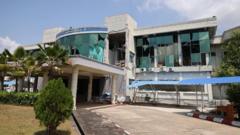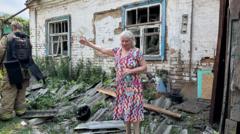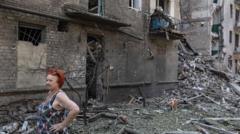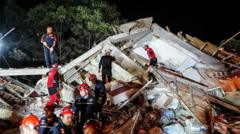In the wake of the recent 7.7 magnitude earthquake that hit Myanmar on March 28, the capital city Nay Pyi Taw is set to have its layout restructured to better withstand future seismic activities. This decision was announced by Senior General Min Aung Hlaing during a government meeting, emphasizing that the buildings collapsed due to poor soil conditions. Evidence suggests that around 70% of the government infrastructure was significantly impacted, prompting some offices to relocate to Yangon. The military reported over 3,500 fatalities and thousands injured in the aftermath of the quake, which was so powerful it resonated as far as Thailand and southwestern China. Having been established only in 2005, Nay Pyi Taw, meaning "seat of the king," was built as a planned capital, characterized by broad roads and empty structures. Amid the ongoing civil conflict in the country stemming from a military coup, a temporary ceasefire was declared to facilitate relief operations, although attacks on rebel areas have persisted. With reconstruction expected to take several years, key departments have begun moving their operations to safer areas, as the city experiences significant distress and disruption.
Nay Pyi Taw's Layout to be Overhauled Following Recent Earthquake

Nay Pyi Taw's Layout to be Overhauled Following Recent Earthquake
Myanmar's capital Nay Pyi Taw will undergo significant structural changes after a devastating earthquake last month caused extensive damage, as stated by the military leadership.
Nay Pyi Taw's Layout to be Overhauled Following Recent Earthquake
Myanmar's capital Nay Pyi Taw will undergo significant structural changes after a devastating earthquake last month caused extensive damage, as stated by the military leadership.
In the wake of the recent 7.7 magnitude earthquake that hit Myanmar on March 28, the capital city Nay Pyi Taw is set to have its layout restructured to better withstand future seismic activities. This decision was announced by Senior General Min Aung Hlaing during a government meeting, emphasizing that the buildings collapsed due to poor soil conditions. Evidence suggests that around 70% of the government infrastructure was significantly impacted, prompting some offices to relocate to Yangon. The military reported over 3,500 fatalities and thousands injured in the aftermath of the quake, which was so powerful it resonated as far as Thailand and southwestern China. Having been established only in 2005, Nay Pyi Taw, meaning "seat of the king," was built as a planned capital, characterized by broad roads and empty structures. Amid the ongoing civil conflict in the country stemming from a military coup, a temporary ceasefire was declared to facilitate relief operations, although attacks on rebel areas have persisted. With reconstruction expected to take several years, key departments have begun moving their operations to safer areas, as the city experiences significant distress and disruption.
Myanmar's capital Nay Pyi Taw will undergo significant structural changes after a devastating earthquake last month caused extensive damage, as stated by the military leadership.
In the wake of the recent 7.7 magnitude earthquake that hit Myanmar on March 28, the capital city Nay Pyi Taw is set to have its layout restructured to better withstand future seismic activities. This decision was announced by Senior General Min Aung Hlaing during a government meeting, emphasizing that the buildings collapsed due to poor soil conditions. Evidence suggests that around 70% of the government infrastructure was significantly impacted, prompting some offices to relocate to Yangon. The military reported over 3,500 fatalities and thousands injured in the aftermath of the quake, which was so powerful it resonated as far as Thailand and southwestern China. Having been established only in 2005, Nay Pyi Taw, meaning "seat of the king," was built as a planned capital, characterized by broad roads and empty structures. Amid the ongoing civil conflict in the country stemming from a military coup, a temporary ceasefire was declared to facilitate relief operations, although attacks on rebel areas have persisted. With reconstruction expected to take several years, key departments have begun moving their operations to safer areas, as the city experiences significant distress and disruption.






















